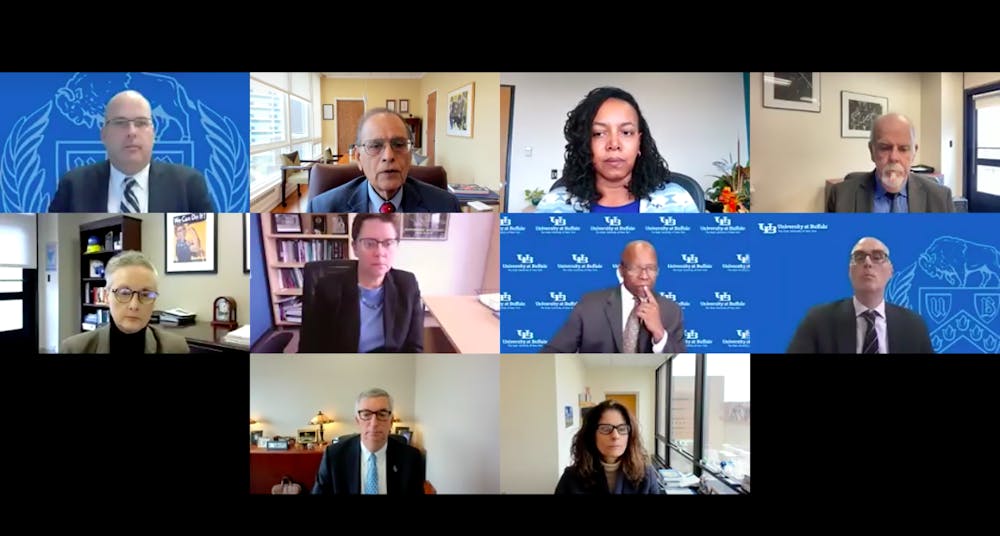UB administrators touted progress on racial equity goals and announced new ones at a virtual town hall over Zoom on Nov. 15 for UB President Satish Tripathi’s Advisory Council on Race.
A new position in the Intercultural and Diversity Center has been filled which will provide staff with more training to support underrepresented students more than they have in the past, especially in areas related to belonging and retention.
Currently, 47% of UB’s student body makes up the BIPOC (Black, Indigenous, people of color) community, with a 5% increase since 2015. Domestic BIPOC students make up 30% of the student body, with a 6% increase since 2015.
Retention plans are being assessed to uphold the university’s goals for diversity in enrollment, Vice Provost for Enrollment Management Lee Melvin.
The university continues to apply a holistic admissions process for undergraduates. UB uses test-optional admissions practices and considers the ethnic, socioeconomic and geographical statuses of students. Race is one of the components of the admissions process, Melvin said, but not a primary component.
That statement came weeks after the U.S. Supreme Court heard oral arguments in a case that could overturn the constitutionality of affirmative action in college admissions.
There are existing programs that serve undergraduate BIPOC students, and the Office of Student Success and Academic Support is actively reviewing those programs. A gap analysis is being conducted to see where more support is needed regarding retention and completion rates, according to Graham Hammill, dean of the graduate school vice provost for academic affairs.
The university is continuing to expand resources and funding to initiatives advancing student diversity, programs and services on campus, Vice President for Student Life Brian Hamluk said.
Ongoing recommendations include incorporating annual celebrations of the diverse UB community, such as awards, events, festivals and heritage months.
The university “constantly seeks out feedback” from student leaders throughout campus regarding efforts that are needed at the university to promote diversity and inclusion, Hamluk said.
The town hall meeting also discussed efforts to create a more inclusive space at UB through “targeting underperforming buildings, spaces and places” on campus with public art and other installations. Several committees and programs are working out the details.
The meeting also highlighted UB faculty and staff, showcasing ongoing efforts to improve recruitment and retention.
Recruitment programs such as iSEED, DVS and VITAL that focus on “enhancing recruitment and establishing networks with universities with underrepresented scholar populations” are continuing to be improved on and expanded, per a Nov. 9 progress report published by the Office of the Provost.
These programs, intended to provide more professional opportunities for students of color, are being expanded across campus with “coordination and communication.”
A new faculty resource, the Faculty Affairs Office, is another strategy that aims to target retention of new underrepresented faculty members with efforts from chairs and deans, according to the Office of the Provost.
Robert Granfield, a sociology professor and vice provost for faculty affairs, talked about UB’s progress in doubling the number of faculty who come from underrepresented backgrounds from 10% in 2019 to 35% in 2022.
The university is currently working with the Faculty Senate to recognize faculty who do “invisible” work and their contributions to diversity, equity and inclusion. This includes underrepresented and women faculty who “often take more service than their colleagues.”
UB is also working on addressing any issues faculty may have through surveys such as Collaborative on Academic Careers in Higher Education (COACHE), and working on other resources such as affinity groups to improve experiences and job satisfaction.
The Advisory Council on Race is comprised of UB faculty, staff, students and alumni who bring their “expertise and experience” to help with the university’s approach to reform efforts, according to the Office of the President.
Kiana Hodge is an assistant news/features editor and can be reached at kiana.hodge@ubspectrum.com
The news desk can be reached at news@ubspectrum.com





